Compound Bow FAQ
A compound is a great bow, but there are heaps of questions about it. Like: how to use it, the terminology, what is draw weight, draw length and the archery accessories that go with it.
In this article we cover a lot of information, set ups and answers to your compound bow FAQ.
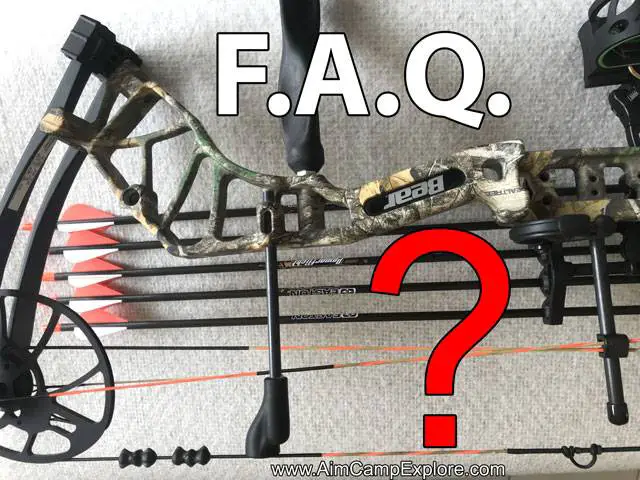
Compound Bow Frequently Asked Questions
What Is The Fastest Bow?
PSE Archery Expedite NXT has a speed of 360 – 352 fps, I.B.O. / A.T.A.
Here are some other speed bows that are very fast, they are:
Mathews Monster Safari at 350 fps I.B.O.
Hoyt has the Twin Turbo blazing fast at 350 fps A.T.A.
The Bowtech SR350 and Revolt XL at 350 fps.
Obsession Archery has the Defcon M2 6 with a speed of 353 fps. I.B.O.
Martin Archery with the ADX 6 at 348 fps.
Darton Archery has the 2022 Maverick XT with a 340 -345 fps.
Bear Archery has both the Refine EKO and Redemption EKO at 342 fps.
For a list of the new fastest bows, visit – Fastest Compound Bow Models
Please Note: Not all bow manufacturers use the same testing parameters.
Some archery brands use the I.B.O. (International Bowhunters Organization) method, others use the A.T.A (Archery Trade Association.) method for measuring the bows speed.
I owned the PSE Omen compound many years ago and it was blazing fast. The speed was rated at 366 fps. This was probably one of the commercially made fastest bows in the world at the time.
How Often Should You Wax Your Compound Bow String?
Depending on much you shoot the bow, you might wax the bowstring every three weeks.
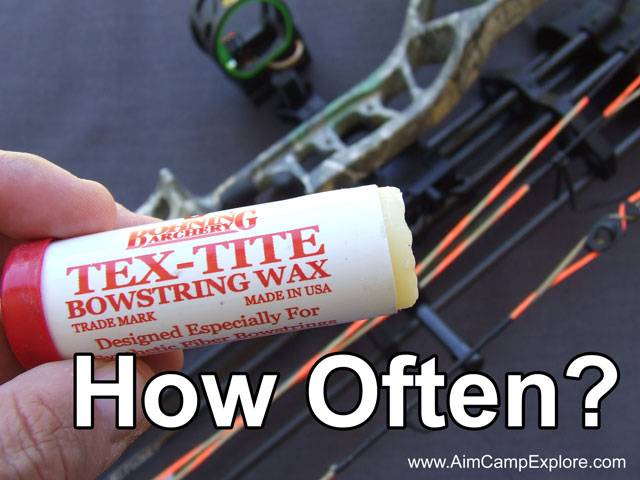
In dry or wet conditions, or if you shoot it a lot, you should wax it fortnightly or more frequently.
This article will give you a more detailed answer – How Often Should You Wax Your Bow String
Also visit the article on Bowstrings to find out about the different types and information on caring for them.
What is the best youth compound bow?
Most well-known bow manufactures like Hoyt, Mathews, Bowtech, PSE Archery, Mission, Bear, Darton, Elite, etc. have good youth compound bows.
My pick for this year is the Diamond Infinite / Edge range with an adjustable draw weight from 7 lbs. to 70 lbs.
To check the latest price, click on – Diamond Infinite / Edge (Affiliate link from Amazon.)
The Diamond Infinite / Edge has many models over many years and has stood the test of time. It maybe one of the best youth compound bows ever built because of its wide range of adjustability and quality.
Also the Bear Archery Legit is another good youth bow with adjustable draw weight from 10 lbs. to 70 lbs.
What is the highest pound compound bow?
You can get custom made bows by some companies with a higher draw weight, but the ones commercially available are the:
Mathews Safari has an 85 lbs. draw weight model available.
Here are some bow manufacturers that have a maximum draw weight range of up to 80 lbs. To name a few model, they are:
Bowtech Revolt XL
Hoyt Archery Ventum Pro 33, Carbon RX – 7, Carbon RX – 7 Ultra
Obsession Archery TM 33, HB33
Prime Archery Inline 1, Inline 3, Inline 5, Nexus 4, Nexus 6, Black 9
PSE Archery EVO XF 33, Carbon Air Stealth Mach 1, Evo EVL 32, Evo EVL 34 EC, Expedite NXT, Nock On Carbon Levitate.
With the exception of elephants and dinosaurs, 80 lbs. will handle most big game. Even 70 lbs. is capable of a lot of game.
What are the top 5 Compound Bow brands?
This answer will depend on the individual archer, but I would say in no particular order that these brands make good bows and have been around a long time:
Hoyt Archery
Mathews Archery
Bowtech
PSE Archery
Bear Archery
I would still check out – Darton Archery, Obsession, Athens Archery, Martin, Diamond Archery, Mission and Elite as well.
For a full list of bow models, draw weights, length, speeds and specs for 2022, visit – New Compound Bow Models
How Do You Tie A D-Loop?
For a step by step guide with pictures, click on – How To Tie A D-Loop
Tie the knots opposing each other.
Test the loop first, don’t draw directly to your face.
How Do You Change A Compound Bows Draw Weight?
On the ends where the limbs meet the bow riser, you will see a limb bolt.
Tightening them down clockwise, you increase the bows poundage.
Loosening the bolts off counter-clockwise, you decrease the bows poundage.
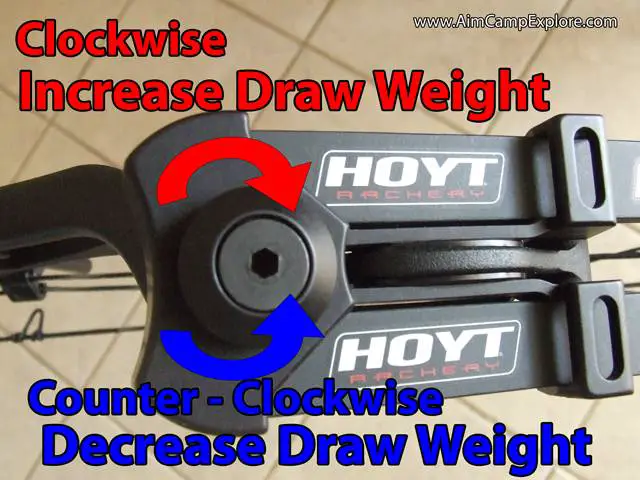
Warning – Do not unwind the limb bolts too many turns. Or the limbs might fly off as they are strung under pressure. The bow manufacture will have the limit on number of turns you can safely do.
Use an Allen key or hex wrench to turn the limbs down to increase the bows poundage.
Just turn the limbs one or two turns at a time. Example. – Adjust the top limb 1 turn. Then adjust the bottom limb 1 turn.
Make sure you turn the top limb and bottom equally in turns. If you don’t, the bow limb may be out of tiller and the cams may turn over at different times causing bow tuning issues.
Tip – Wind down the limb bolts on both limbs equally all the way down. Use a sharpie to mark the limb bolts so you know that they are even when adjusting them.
For more detail on adjusting the draw weight, visit the article – How To Increase A Compound Bow’s Draw Weight
How Do You Change A Compound Bows Draw Length?
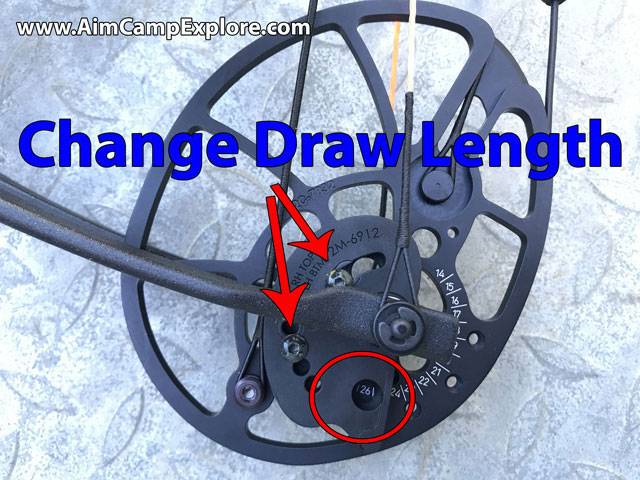
Luckily these days, you don’t need a bow press to adjust the draw length on most compound bows.
Unfortunately, most instructions from the bow manufactures are non-existent or hard to follow.
Basically you have 2 different ways, depending on compound bow model.
You can have adjustable mods, or rotating modules on the cams.
With most you use an Allen key to unscrew the modules. You then reposition the modules in the corresponding number to get your desired draw length.
As an example module “A” = 28” draw length. Module “B” will give you a 29” draw length.
Most bows come from the manufacturer set at 29” draw length. Which is surprising as the average male might be around 28” draw length, depending on the archers limb length and shooting style. (I guess it means a little bit more arrow speed with a longer draw length, and as we know, speed sells.)
Ensure the draw length suits the archer. Most compound bow archers have the draw length too long and this negatively affects the accuracy of the archer.
For more information, click on – How To Figure Out Your Draw Length
What is the best compound bow brand?
This is a similar question as the top five best compound models as above in the article. This will depend on the archer’s preference and there are plenty of good brands which include:
PSE Archery, Bear, Bowtech, Hoyt Archery, Elite, Martin, Mathews Archery, Mission, Diamond Archery and Darton to name a few.
While there are probably other reputable brands I don’t know about, stick with common well-known brands.
Avoid the eBay unbranded or unheard of compounds. (And arrows as well as they can be dangerous if they are poor quality shooting out of a fast compound.)
How Do You Measure A Compound Bows Brace Height?
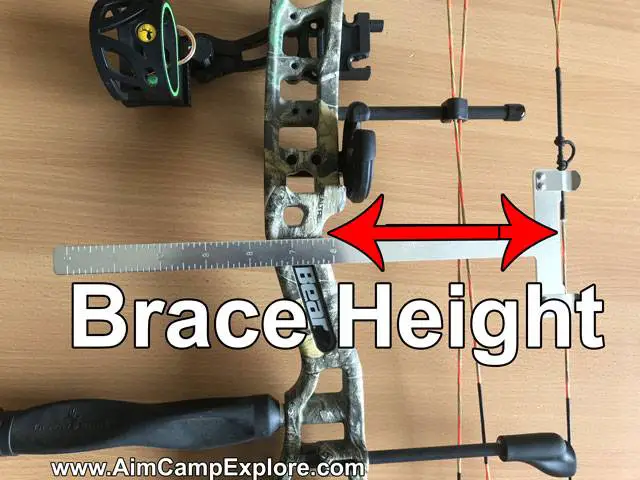
You measure the bows brace height by the deepest part of the grip to the bowstring. (Not at full draw)
How Do You Measure A Compound Bows Draw Length?
A bow’s draw length is measured from the arrow nock groove when at full draw to the deepest part of the grip, plus 1 ¾”.
This is the compound bows draw length and should not be confused with the archers draw length. Make sure you adjust the bow to suit your ideal draw length.
For more information, visit – Correct Draw Length
Can You Use A Compound Bow Without A Release Aid Device?
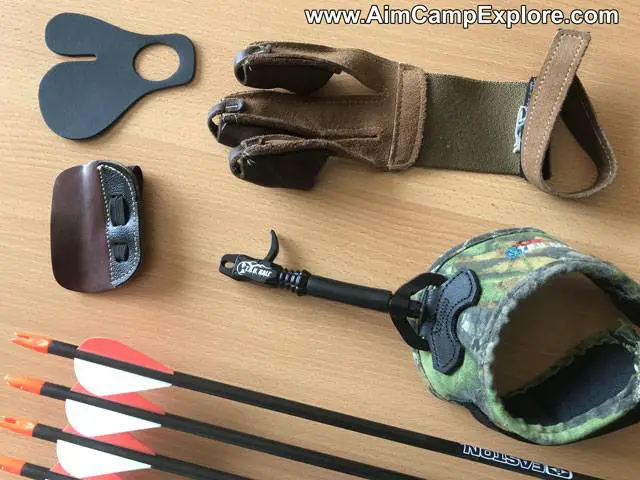
Yes you can use a compound with fingers, (use tab or glove protection) however, it ideally has to be a longer length compound to release it more accurately.
You can shoot the compound bow with a short length with fingers, but the finger pinch can make the release (loose) hard. The angle of the string is very acute for short bows.
So if you don’t want to use a release aid device, select a longer length axle to axle compound bow for finger release.
The advantages of ditching the release aid device for bowhunting and using fingers might include:
- Bowhunters may enjoy not having an extra piece of equipment of the release aid device that may fail.
- A release aid may be slower for some to knock and arrow and slower to get of an arrow off. (Especially if your adrenaline is going with a big buck.)3. Another point is it can make excessive noise when knocking an arrow. (Wrist strap release banging on the riser.)4. Bowhunters (and target archers) may forget to bring the release aid device with them. I have nearly left mine at home a few times and know plenty of archers who forget it. Tip – clip it on your string in your soft bow case or have a dedicated spot for it in your hard bow case.
Note: Chuck Adams a great bowhunter preferred a longer compound bow length. He used a finger release and bow sights, he is a very talented hunter and archer. Chuck has written many articles for bowhunting magazines and is the author of two books: Super Slam, Adventures With North American Big Game.
My Life At Full Draw, the Chuck Adams Story.
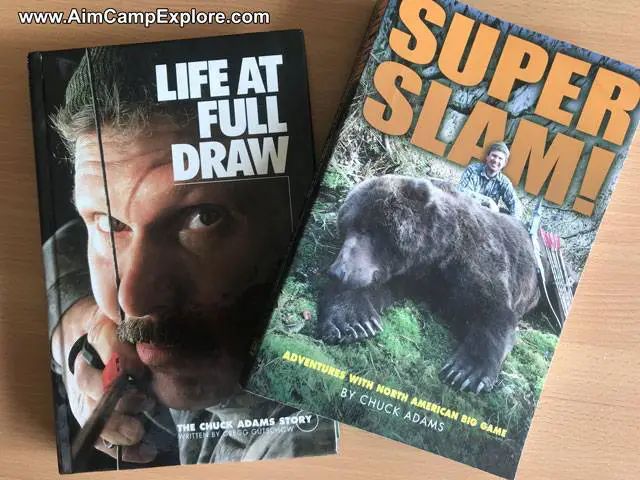
How Do You Use A Compound Bow Without A Release Aid Device?
You can use a finger release with a compound, with sights or barebow. (No sights attached.)
This can be used for both target archery and bowhunting. However a lot of target organizations don’t include a category of using a compound bow with sights and using fingers for the release. (No release aid device.)
With barebow shooting, you do not have a mechanical sight attached to the bow, but you have a number of aiming systems you can use in archery. Like: Gap shooting, split, string walking, instinctive, face walking and point of aim systems. For more information on how to aim a bow, visit – How To Aim A Bow And Arrow.
What Does Axle To Axle Mean On A Bow?
It is the length of a compound bow, measured from axle to axle.
A.T.A. can stand for “Axle To Axle.” (Or A.T.A. also stands for Archery Trade Association.)
A short axle to axle bow might be 28” A long length bow might be 40” length.
Most bows range from 30” to around 34” for bowhunting compound bows.
Target compounds might be around 34” 35” to 40” length range. But this will depend on the archer’s preference and style and there is no hard rule.
How To Measure Axle To Axle On A Bow?
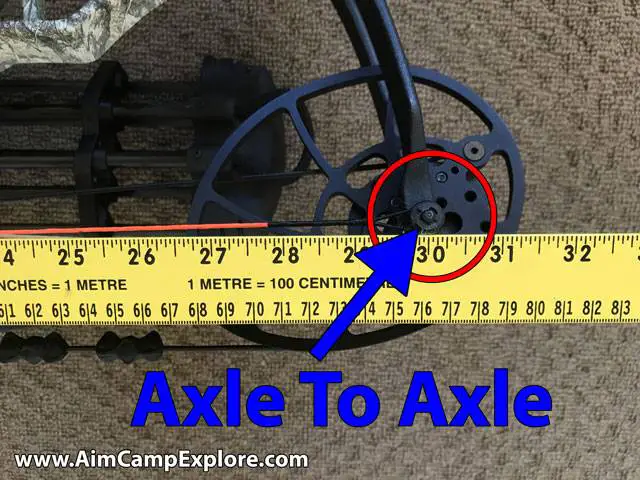
It is measured by the center of the axle (the axle holds the cams or wheels on the limbs) to the other end of the center of the axle.
The end point of the cams to cams are NOT measured.
Be aware if you buy a bow case, you measure the whole length, so you know it will fit in the case. (Not just axle to axle length.)
Long Vs Short Axle To Axle Bows.
Stability and reduced torque can be an advantage for the target archer because of the longer length bow.
With long compounds, the string angle is reduced and is ideal for finger shooters.
A longer bow might accommodate a longer draw length archer better.
For a list of bow that have a long draw length, click on – Long Draw Length Compound Bow Models
Longer compound bows can mean more mass weight, which can be a positive or negative. (Example, a heavier mass weight can absorb more recoil and make the bow shoot quieter. It might hold on target better at full draw.)
Longer compounds are harder to find new from bow manufacturers.
For a list of long compounds, visit – Long Axle To Axle Compound Bow Models 2022
A short compound is ideal for saddle or tree stand hunting. In pit blinds and hides it can be maneuvered easier.
For stalking in long brush a shorter bow can be easier to carry and less chance of catching bushes and long grass.
A shorter compound can be lighter to carry longer distances.
A light short compound is ideal for youths and small framed archers.
Short compounds are readily on the market and store easily.
What type of arrow should never be used in a compound bow?
- Wood arrows
2. Bad quality, no brand arrows.
3. Weak under spined arrows not suitable for your bow.Wood arrows should NOT be used in a modern compound. Because of the modern efficient design of the compound, it can place a lot of stress on the arrow.
(I remember using wood arrows with compound bows in the late 1980’s. However, most compounds weren’t that much faster in speed then a good recurve or well-made longbow.)
Do NOT use cheap no-brand carbon arrows from eBay or Amazon, as they can be poor quality and break when fired.
Stick with well-known arrow brands like Easton arrows, Gold Tip, Carbon Express, Victory, Beeman, etc. Carbon and aluminum arrows that are properly spined for your bow can be used if it matches your bow specs. (Such as draw weight and draw length.)
Weak under-spined arrows, not matched for your bow should NOT be used, as they can splinter and break.
Do you need a peep sight on a compound bow?
No, you can use a compound without a peep sight.
Some bowhunters don’t like the limited vision through a peep sight, especially in low light conditions
You can line the bow string in line, or either side of bow sight pin when at full draw. (That’s what old time compound archers and Olympic recurve shooters do for extra reference points.)
Another point of reference is using a kisser button.
For best accuracy if you use bow sights, a peep sight is worth considering.
For bowhunting try a Tri-peep, or aperture with a bigger hole to let more light in.
What is the draw cycle with a compound bow?
The phases that the bowstring, cams and limbs go through from start to finish when pulling to full draw.
This is the movement when you start to draw back the bow, to when the cams turn over and then the let – off at full draw. Finally the archer will hit the wall, where the bow can’t be drawn any further.
Some bows have a very smooth draw cycle and are a pleasure to shoot. As long as the draw weight is correct for the archer, the bow feels nice to draw it back.
Other bows, like fast speed bows, can have an aggressive hump to pull back. Even if the poundage is correct, the bow is hard to pull back. The draw cycle is bumpy as the draw weight increases rapidly, then goes to the let-off (valley) phase, then the wall.
What is the hump in a compound bow draw cycle?
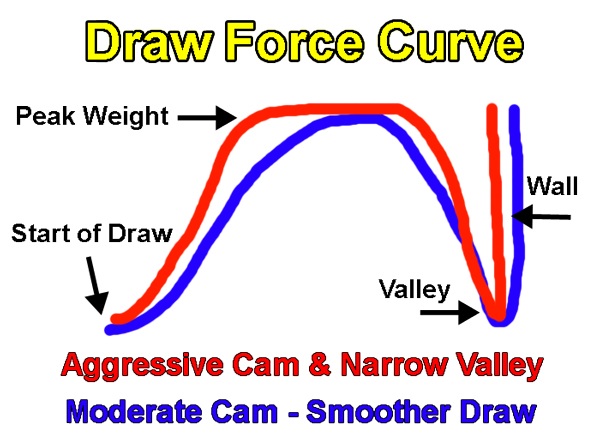
When you pull back a compound, the draw weight increases rapidly, then the poundage drops off at full draw. Where the poundage ramps up, it is sometimes called the hump or peak weight.
Some bows have an aggressive hump, other bows have a smoother draw.
What is the compound bow let-off?
When the archer draws back the compound bow, the poundage increase dramatically to a peak. Then the cams turn over and the weight of the bow decreases, which is the let-off phase.
The archer will feel the let-off of holding less weight, which can be called the valley.
Some compounds can have a let-off from 60%, 75% 80% even up to 90% depending on manufacturer and model. Some bows have an adjustable let-off.
For an easy example, a bow with a 50% let-off with a 60 draw weight, means the archer is holding 30 lbs. at full draw.
For another example, a 70 lbs. compound with 80% let-off means they are holding 14 lbs. at full draw.
(For a longbow or recurve bow, they don’t have a let-off. As an example a recurve archer drawing a 50 pound bow @28” will be holding the full weight of 50 pounds at full draw at 28”.)
What is the wall in a compound bow?
As the bow goes through the draw phases, of ramping up the poundage, then the let off, the archer then will feel the compound bow can’t be drawn any further, this is the wall.
This is adjusted from the draw length setting. So if the archer buys a compound with a 27” to 29” bow, the bow can be changed to either a 27”, 28” or 29” draw length.
Some compounds also can be changed in half in increments as well.
(For a recurve or longbow or bow, they don’t have a wall. However the bow can “stack”, that is be very hard to draw past the designed draw length for the bow, until the bow can’t be drawn anymore.)
Does Browning make a compound bow?
Unfortunately Browning does not make any compounds any more.
(The very old ones had a beautiful wooden riser that looked stunning.)
What distance should you sight in a compound bow?
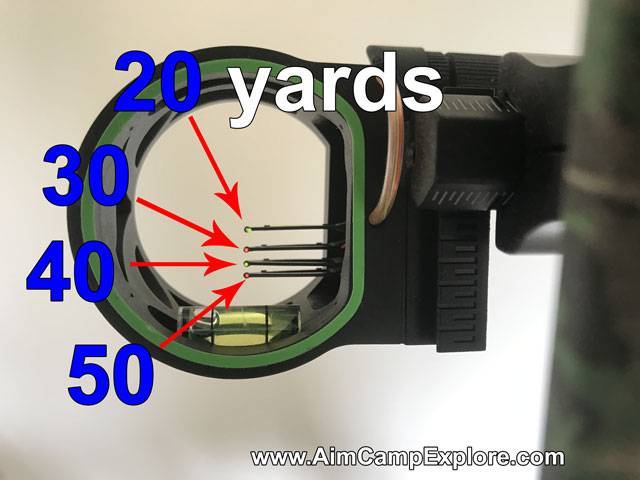
For bowhunting you might consider sighting the pins for 20 yards, 30 yards, 40 yards and 50 yards.
(Or 20, 30, 40, 50 meters.)
You might never plan on taking a 50 yard shot if you are a beginner, but it is good for practice to shoot arrows at a longer distance. When you go back to a 20 yard target, this can seem easy.
If you only have a three pin bow sight, all good, just sight it in for 20, 30, 40 yards or meters.
Some beginner bowhunters ask, “Why not set the bow sight pins for 10 yards as well?” You can just use your 20 yard pin and aim a touch lower.
If you have a flat shooting compound and have five sight pins, you might set the sight for 20 yards, 30 yards, 40 yards, 50 yards and even 60 yards.
Once again you might not plan on taking a 50 or 60 yard shot (and not recommended) but practice at these long distance is invaluable. Safety first and have a big safe area and back stop.
Too many pins can take up your bow sight real-estate, which in low light can be an issue. Also it can be confusing sometimes in the heat of or excitement of seeing a big buck, to know which pin is which distance.
If you do field archery or 3D archery, find out what distance the targets range from. Work out what would make the most sense to sight your bow in for these distances. (There is no sense sighting in your bow at 50 yards, and targets are from 7 yards to 40 yards at unmarked distances.)
What is the distance the majority of targets are set at?
Depending on the target archery organization and rules, you might shoot 50 meters and 70 meters. For indoors target archery it might be 18 yards.
Just a tip on archery practice, always finish your last shot with a good shot. If I was practicing by myself at 40 yards, for the last arrow I would end on a good shot. If not I would get very close to the target, around 5 yards for my last shot and release a good arrow in the gold (bullseye) or spot target. (Some target clubs may not allow this at a practice range.) This just helps the mindset that you ended your practice session on a good shot.
Do you need an arrow rest on a compound bow?
Yes, it is advised to use an arrow rest on a compound.
With the plastic vanes (fletching) on the arrow can hit the hard shelf or riser of the bow, sending the arrow flying inconsistent from one release (loose) to the next.
The shelf is also cut past center on the compound bow, so the arrow has no exact place to sit.
With an arrow rest it helps guide the arrow to be in the one precise place when drawing the bow and releasing the arrow.
The arrow rest will minimize the contact between the plastic vanes and getting more consistent, better accuracy and speed.
When bow tuning, an arrow rest also makes it easier to adjust it for more consistency.
For bowhunting some arrow rests like a whisker biscuit, can help the arrow stayed nock on the bowstring easier.
Some bowhunting arrow rests are quiet and stop your arrow from noisily knocking on the bow’s metal riser and scaring game away.
(For my first compound I had when I was young, I didn’t have an arrow rest. But after reading heaps of archery books and bowhunting magazines, realized it was better getting one.)
Is a compound bow better than a longbow?
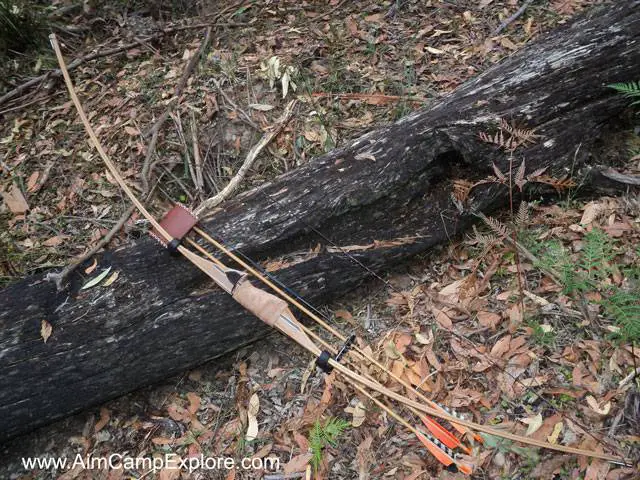
It depends on the archer. I love shooting both.
For shooting longer distances, a compound bow with a release aid device and bow sights, a beginner can get more consistent quickly at longer distances.
However for simplicity, tradition and fun, a longbow is hard to go past.
A longbow can be shot very quickly. There is also minimal parts and things to break or come loose.
But with a compound bow, the arrow speed can be very fast and easier to hold at full draw with the let-off.
They both have pros and cons. Try them both out.
What is the fastest PSE compound bow?
The fastest in the PSE Archery line is the Expedite NXT at 360 – 352 fps, IBO / ATA speeds.
Note: I.B.O. (International Bowhunters Organization) and A.T.A. (Archery Trade Association.) use different criteria for testing the speed of the bows.
Do you wax the cables on a compound bow?
Yes, wax the cables. But be careful where it contacts the cams or cable guard that the excess wax doesn’t clog up the tracking.
Burnish the bowstring and get rid of the extra wax.
You can wax the bowstring serving as well.
Is an old compound bow safe to shoot?
Without taking it to an archery pro shop, I would have to say – No.
The bowstring might be worn out and frayed.
It might have a crack or cracks in the limbs.
The bow might have been dry fired and damaged.
Get it inspected first, and then if it is okay, shoot it.
You might have to replace the bowstring and cables on it.
Is a compound bow more powerful than a recurve?
Yes, a compound will zap an arrow a lot faster than a recurve and longbow. All being equal in bow draw weight, draw length, arrow weight and quality of the bow.
Is a stabilizer necessary on a compound bow?
No, you can shoot it without one. I have had plenty of bowhunting bows where I didn’t use one. You can save weight by not putting one on the bow.
However, they are good for helping hold on target and for following through on the release of the shot. They can also reduce vibration and a bit of noise as well.
To give yourself a level playing field in target archery, field archery and 3D, it is advised to have one.
Is PSE a good compound bow?
Yes, I have had several PSE compound bows over 30 years, both target and bowhunting models. (And also Hoyt, Bear and Mathews bows, etc.)
Check out the PSE Stinger for a good beginner model for bowhunting and general use.
PSE has also makes a several nice target compounds as well.
What is a good FPS for a compound bow?
Most adult compounds shoot over 310 F.P.S. (feet per second) depending on draw weight and draw length. This is more than adequate enough for most types of archery and bowhunting.
320 fps is a good speed. When you start talking above 330 fps, the bow is starting to get fast.
Over 340 fps and 350 fps is getting very fast.
I wouldn’t go purely on speed of the bow as there are so many other factors involved. Like what the bow is going to be used for, such as bowhunting, target archery, field Archery or 3D archery?
Also the feel draw cycle, grip, balance, look and price come into play.
Remember it is the archer’s skill first that dictates accuracy. As there is no sense having a fast bow if the archer can’t hit the target. It just misses the target faster.
What is the cable guard on a compound bow?
The cable guard holds the cables away from the arrows fletching when the bowstring is released.
Otherwise the fletching (plastic vanes or feather fletching) can hit the cables and interfere with the arrows flight.
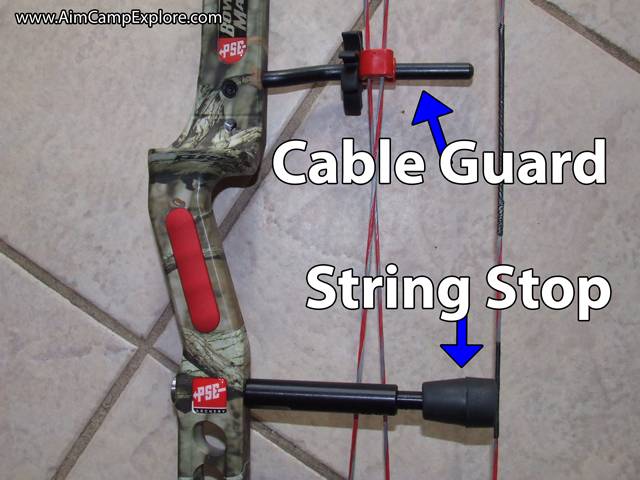
What is a string stop on a compound bow?
The string stop is designed to stop the bowstring at a set place to increase accuracy and reduce oscillation.
On some Bear archery compound’s they have two string stops.
Can you shoot a compound bow without a string stop?
Yes you can, the compounds twenty years ago didn’t have bowstring stops on them.
However, if the manufacturer supplies it, it can help reduce excess string vibration, oscillation and noise.
What is a non-compound bow called?
There are three basic types of bows, they are the 1. Longbow, 2. Recurve Bow, 3. Compound Bow
If you include a crossbow, then you might classify four types of bows.
For more information, visit – Types Of Bows
Which bow is better compound or recurve?
I enjoy shooting both, so this would be a personal preference.
With bow sights and release aid device on a compound bow, you can get accurate reasonable quicker than a recurve. (Depending on archer’s skill and how much they practice.)
A compound will fling an arrow faster than a recurve. (Same draw weight, draw length, arrow weight on both bows.) But speed isn’t everything.
With a recurve you have got less working parts to fail. You may shoot a recurve and longbow with no sights for bowhunting, so it can be quick to get off a shot.
A wooden bowhunting recurve is lighter. But a compound is shorter for still hunting, stalking, pit blind or tree stand hunting.
For Olympic Target Archery, a compound isn’t allowed to be used, just recurve bows. (The exception is they tried compounds out at the Tokyo Olympics.) Check out for what gear is used, click on – Olympic Archery Equipment Checklist.
With a recurve bow, it is just fun to shoot.
Longbow, recurve or compound, it is all good!
Do you need a release aid device for a compound bow?
As discussed above, you can shoot a compound bow without one. You will need some form of finger protection though, like a glove or archery tab.
Ideally the compound will be a longer axle to axle bow, so to reduce the finger pinch angle of the bowstring at full draw.
Where is the Nocking point on a compound bow?
This is placed on the bowstring and is where you place, or nock your arrow.
Some archers use a D-Loop and nock point, so the D-Loop doesn’t slide down the bowstring after a while.
A tied in nock-set can work in well with a D-loop and reduce nock pinch on the arrow.
Can you shoot Flu Flu arrows compound bow?
Yes, you can use Flu Flu arrows. However, certain arrow rest may be an issue with them, such as a whisker biscuit and can rough the feathers up a bit.
Is Hoyt a good compound bow?
Hoyt boys are very widely respected in target archery and bowhunting circles. They have been manufacturing target and bowhunting compounds, as well as target recurve bows for a long time.
Is a compound bow more accurate than a recurve?
They are both equally accurate and more accurate than a human can shoot.
A compound bow has the advantage over longer distances for the archer, as they normally use a release aid device that can loose (release) the bowstring without too much interference.
Also the compound bow has a left off, so the archer isn’t holding as much draw weight at full draw.
Overall it will depend on the archer’s skill, but both are similarly accurate, if you take the human factor out of the equation.
How long can you leave a compound bow strung?
You can leave the compound strung indefinitely.
However, if you put it in long term storage, reduce the draw weight poundage on it to the minimum. So there is less weight and stress on the limbs, riser, cams, cables and bowstring.
Don’t store the bow it hot places, or damp areas.
What is the proper way to hold a compound bow?
This will depend what discipline you are shooting and style, such as using sights or canted using barebow shooting. (No sights on the bow.)
However, for most using bow sights, the bow is held vertically straight up and down, the hand grip should be minimally contacting the bow to reduce torque.
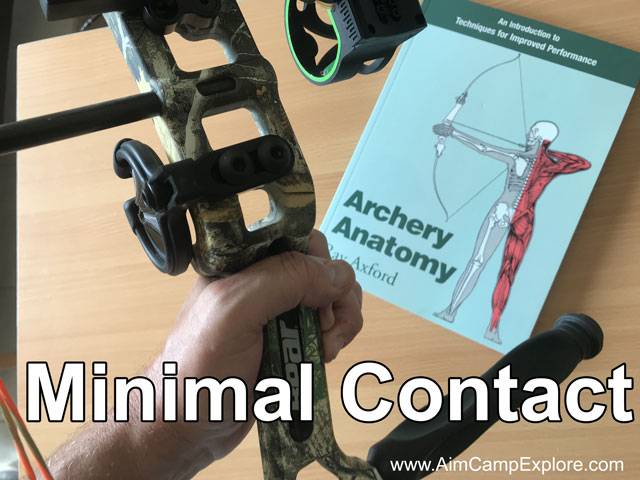
With the above picture, only two of my fingers are on the bow grip. (Archery Anatomy by Ray Axford has some good information.)
Bow arm alignment (arm holding the bow) is very important, as bone to bone will fatigue less than using muscles alone in the arm when at full draw and using back tension.
The weight of the compound will hold nicely on target (if balanced correctly) and the less human interference on the grip the better. That is why you will see most target archers using finger and wrist slings with minimal hand contact.
Some bowhunters us a bow sling to reduce contact on the bow.
(For some longbows and bowhunting recurves you have to hold it firmly while shooting it.)
Who makes the BlackOut Intrigue XS compound bow?
Diamond Archery / Bowtech makes the BlackOut Intrigue XS.
What do the numbers on my compound bow mean?
This will depend on the manufacturer, but some abbreviations and numbers might mean:
DL = Draw Length
DW = Draw Weight. Or it might state (Example) 60 – 70 lbs.
SL = String Length
ATA = Axle To Axle
BH = Brace Height
Draw weight is the range the poundage or draw weight can be adjusted. As an example it might state 50 lbs. – 60 lbs. This is the poundage it can be set between. Such as 50 lbs., 51 lbs., 52 lbs. etc.
Draw length. For a compound it might read something like 27” – 30”. Which means it can be adjusted in draw length from 27”, 28” 29’ and 30” to suit the archer.
What is the best compound bow stabilizer?
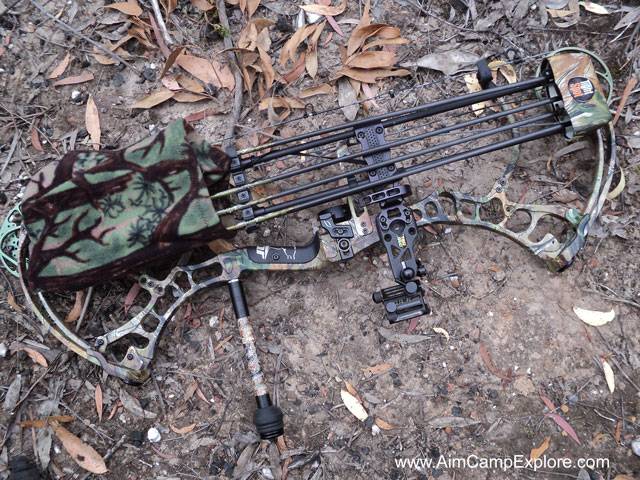
For bowhunting the Bee Stinger stabilizer is a winner for me.
For target archery, I still haven’t figured that out and have tried a few different brands, designs, lengths and types. I would stick to the well-known brands.
What is the best compound bow quiver?
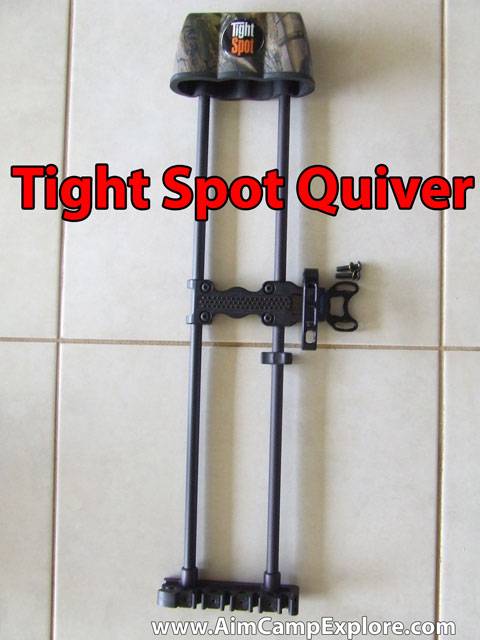
The Tight Spot bow quiver is hands down my favorite for a compound. It can not only be adjusted up and down to accommodate for the length of your bow and arrows, but also the angle.
It also fits close to the bows riser, so you haven’t got a lot of weight far out from the bow, to unbalance it more when aiming.
The hood covers up the broadheads well. Unlike some bow quivers that at the hood is short and the broadhead blades are exposed and can be dangerous.
A Tight Spot has plenty of colors available and grips the arrows well.
Is Bear a good brand of compound bow?
Yes, a good brand at a reasonable price. There is a lot of history with Fred Bear and Bear Archery and they make fine bowhunting compounds and recurves.
One of my favorites was the Bear Archery Carnage. Quiet, fast and held rock steady on target for me. (I wish I never sold it.)
The Bear Legit is a great bow for children and young beginners.
Can you shoot a compound bow instinctively?
You certainly can use instinctive shooting. However, there are many other methods of barebow shooting that might get you accuracy a lot quicker, like gap shooting.
In gap shooting you use the arrow point or riser as a reference point, below, above or on the target.
Because you normally use fingers (tab or glove) and not a release aid, the compound bow length, axle to axle ideally should be longer to reduce bowstring pinch.
The arrow rest should have some side pressure to allow the finger release as well. A drop away arrow rest or Whisker Biscuit generally won’t work as well.
Can a beginner use a compound bow?
Yes, a compound bow makes a great choice for beginners in archery because of the let- off with bow. So the archer doesn’t have to hold as much weight at full draw.
With sights and release aid device, a beginner can get reasonable accurate within a short time quickly, depending on skill and practice.
Having said this though, the compound has more moving parts and more can go wrong. You also have to make sure the draw length on the bow fits or is adjusted to the archer.
(With a recurve you don’t have a set or limited draw length. The bow is normally designed to be a certain draw weight at 28”. Unless they are a tall archer where the recurve bow draw length might not be long enough, under 28” draw length is not an issue.)
Also with too many things like a release aid device, sights, stabilizers on a compound bow, it can get overwhelming for some youngster or beginners in archery starting out.
Ideally try a compound, longbow and recurve as well and see what you like. (Hopefully though you don’t like shooting all three types of bows. Otherwise you can get a big collection of all different types of bows.)
How often should I replace my bowstring and cables?
Depending how often you shoot, every two years or three years. Or when the cables and bowstring gets worn, like excessive wear, or frayed or cut strands.
Resources And Extra Information
Tips On Archery Shooting and Hacks
